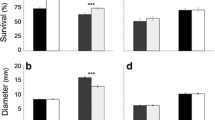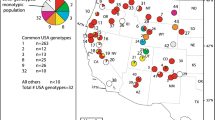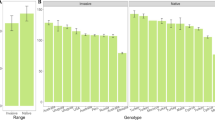Abstract
Invasive populations often grow more vigorously than conspecific populations in the native range. This has frequently been attributed to evolutionary changes resulting either from founder effects, or from natural selection owing to enemy release. Another mechanism contributing to evolutionary change has largely been neglected in the past: Many invasive plant species do actually descend from cultivated plants and were therefore subject to breeding, including hybridization and artificial selection. In a common garden experiment, we compared invasive Central European populations of the ornamental shrub, Mahonia, with native populations of its putative parental species, Mahonia aquifolium and M. repens, from North America. We hypothesized that plants of invasive populations show increased growth and retained high levels of heritable variation in phenotypic traits. Indeed, invasive Mahonia plants grew larger in terms of stem length, number of leaves and above-ground biomass than either of the two native species, which did not differ significantly from each other. Since there are no hints on release of invasive Mahonia populations from natural enemies, it is likely that hybridization and subsequent selection by breeders have lead to an evolutionary increase of plant vigour in the introduced range. Further on, heritable variation was not consistently reduced in invasive populations compared with populations of the two native species. We suggest that interspecific hybridization among the Mahonia species has counteracted the harmful effects of genetic bottlenecks often associated with species introductions. Based on this case study, we conclude that, more attention has to be paid on the role of plant breeding when assessing the mechanisms behind successful plant invasions in future.

Similar content being viewed by others
References
Ahrendt LWA (1961) Berberis and Mahonia. A taxonomic revision. J Linn Soc Lond Bot 57:1–410
Allendorf FW, Lundquist LL (2003) Introduction: population biology, evolution, and control of invasive species. Conserv Biol 17:24–30
Arnold ML, Hodges SA (1995) Are natural hybrids fit or unfit relative to their parents? TREE 10:67–71
Auge H, Brandl R (1997) Seedling recruitment in the invasive clonal shrub, Mahonia aquifolium Pursh (Nutt.). Oecologia 110:205–211
Auge H, Brandl R, Fussy M (1997) Phenotypic variation, herbivory and fungal infection in the clonal shrub Mahonia aquifolium (Berberidaceae). Mitt dtsch Ges allg angew Ent 11:747–750
Ayres DR, Garcia-Rossi D, Davis HG, Strong DR (1999) Extent and degree of hybridization between exotic (Spartina alterniflora) and native (S. foliosa) cordgrass (Poaceae) in California, USA determined by random amplified polymorphic DNA (RAPDs). Mol Ecol 8:1179–1186
Barrett SCH, Husband BC (1990) Genetics of plant migration and colonization. In: Brown AHD, Clegg MT, Kahler AL, Weir BS (eds) Plant population genetics, breeding, and genetic resources. Sinauer, Sunderland, pp 254–277
Blair AC, Wolfe LM (2004) The evolution of an invasive plant: An experimental study with Silene latifolia. Ecology 85:3035–3042
Blossey B, Noetzold R (1995) Evolution of increased competitive ability in invasive nonindigenous plants: A hypothesis. J Ecol 83:887–889
Bossdorf O, Auge H, Lafuma L, Rogers WE, Siemann E, Prati D (2005) Phenotypic and genetic differentiation between native and introduced plant populations. Oecologia 144:1–11
Cabin RJ, Mitchell RJ (2000) To Bonferroni or not to Bonferroni: when and how are the questions. Bull Ecol Soc Am 81:246–248
Caroll SP, Dingle H (1996) The biology of post-invasion events. Biol Cons 78:207–214
Clement EJ, Foster MC (1994) Alien plants of the British Isles. Botanical Society of the British Isles, London
Crawley MJ (1987) What makes a community invasible? In: Gray AJ, Crawley MJ, Edwards PJ (eds) Colonization, succession and stability. Blackwell Scientific Publications, Oxford, pp 429–453
Cross JR (1982) The invasion and impact of Rhododendron ponticum in native Irish vegetation. J Life Sci Roy Dublin Soc 3:209–220
DeWalt SJ, Hamrick JL (2004) Genetic variation of introduced Hawaiian and native Costa Rican populations of an invasive tropical shrub, Clidemia hirta (Melastomataceae). Am J Bot 91:1155–1162
Durka W, Bossdorf O, Prati D, Auge H (2005) Molecular evidence for multiple introduction of garlic mustard (Alliaria petiolata, Brassicaceae) to North America. Mol Ecol 14:1697–1706
Ellstrand NC, Schierenbeck KA (2000) Hybridization as a stimulus for the evolution of invasiveness in plants. Proc Natl Acad Sci USA 97:7043–7050
Erfmeier A, Bruelheide H (2005) Invasive and native Rhododendron ponticum populations: Is there evidence for genotypic differences in germination and growth? Ecography 28:417–428
Facon B, Jarne P, Pointier JP, David P (2005) Hybridization and invasiveness in the freshwater snail Melanoides tuberculata: hybrid vigour is more important than increase in genetic variance. J Evol Biol 18:524–535
Falconer DS, Mackay TFC (1996) Introduction to quantitative genetics. Longman, Essex
Gaskin JF, Schaal BA (2002) Hybrid Tamarix widespread in US invasion and undetected in native Asian range. Proc Natl Acad Sci USA 99:11256–11259
Hochberg Y (1974) Some Conservative Generalizations of the T-Method in Simultaneous Inference. J Multivariate Anal 4:224–234
Hollingsworth ML, Hollingsworth PM, Jenkins GI, Bailey JP, Ferris C (1998) The use of molecular markers to study patterns of genotypic diversity in some invasive alien Fallopia spp. (Polygonaceae). Mol Ecol 7:1681–1691
Houtman RT, Kraan KJ, Kromhout H (2004) Mahonia aquifolium, M. repens, M. x wagneri en hybriden. Dendroflora 41:42–69
Keane RM, Crawley MJ (2002) Exotic plant invasions and the enemy release hypothesis. TREE 17:164–170
Kitajima K, Fox AM, Sato T, Nagamatsu D (2006) Cultivar selection prior to introduction may increase invasiveness: evidence from Ardisia crenata. Biol Invasions 8:1471–1482
Kowarik I (1992) Einführung und Ausbreitung nichteinheimischer Gehölzarten in Berlin und Brandenburg. Verhandlungen Botanischer Vereine Berlin Brandenburg 3:1–188
Kühn I, Klotz S (2003) The alien flora of Germany—basics from a new German database. In: Child LE, Brock JH, Brundu G, Prach K, Pysek P, Wade PM, Williamson M (eds) Plant invasions: ecological threats and management solutions. Backhuys Publishers, Leiden, pp 89–100
Lawrence MJ (1984) The genetical analysis of ecological traits. In: Shorrocks B (ed) Evolutionary ecology. Blackwell Scientific, Oxford, pp 27–63
Lichtenthaler HK, Wellburn AR (1983) Determination of total carotenoids and chlorophyll a and b of leaf extracts in different solvents. Biochemical Society transactions 11:591–592
Lohmeyer W, Sukopp H (1992) Agriophyten in der Vegetation Mitteleuropas. Schriftenreihe für Vegetationskunde, Vol. 25, Bonn-Bad Godesberg
Lynch M, Walsh B (1998) Genetics and analysis of quantitative traits. Sinauer Associates, Inc. Publishers, Sunderland
Mack RN (2000) Cultivation fosters plant naturalization by reducing environmental stochasticity. Biol Invasions 2:111–122
Mandak B, Pysek P, Bimova K (2004) History of the invasion and distribution of Reynoutria taxa in the Czech Republic: a hybrid spreading faster than its parents. Preslia 76:15–64
Maron JL, Vila M, Bommarco R, Elmendorf S, Beardsley P (2004) Rapid evolution of an invasive plant. Ecol Monograph 74:261–280
Milne RI, Abbott RJ (2000) Origin and evolution of invasive naturalized material of Rhododendron ponticum L. in the British Isles. Mol Ecol 9:541–556
Moody ML, Les DH (2002) Evidence of hybridity in invasive watermilfoil (Myriophyllum) populations. Proc Natl Acad Sci USA 99:14867–14871
Moran MD (2003) Arguments for rejecting the sequential Bonferroni in ecological studies. OIKOS 100:403–405
Neuffer B, Auge H, Mesch H, Amarell U, Brandl R (1999) Spread of violets in polluted pine forests: morphological and molecular evidence for the ecological importance of interspecific hybridization. Mol Ecol 8:365–377
Parker IM, Rodriguez J, Loik ME (2003) An evolutionary approach to understanding the biology of invasions: Local adaptation and general-purpose genotypes in the weed Verbascum thapsus. Conserv Biol 17:59–72
Piper CV (1922) The identification of Berberis aquifolium and Berberis repens. Contributions from the United States National Herbarium 20:437–451
Preston CD, Telfer MG, Arnold HR, Carey PD, Cooper JM, Dines TD, Hill MO, Pearman DA, Roy DB, Smart SM (2002) The changing flora of the UK. DEFRA, London
Reichard SH, Hamilton CW (1997) Predicting invasions of woody plants introduced into North America. Conserv Biol 11:193–203
Rieseberg LH, Kim S-C, Randell RA, Whitney KD, Gross BL, Lexer C, Clay K (2007) Hybridization and the colonization of novel habitats by annual sunflowers. Genetica 129:149–165
Roach DA, Wulff RD (1987) Maternal effects in plants. Annul Rev Ecol Syst 18:209–235
Roß C, Durka W (2006) Isolation and characterization of microsatellite markers in the invasive shrub Mahonia aquifolium (Berberidaceae) and their applicability in related species. Mol Ecol Notes 6:948–950
Rossiter MC (1996) Incidence and consequences of inherited environmental effects. Annul Rev Ecol Syst 27:451–476
Sakai AK, Allendorf FW, Holt JS, Lodge DM, Molofsky J, With KA, Baughman S, Cabin RJ, Cohen JE, Ellstrand NC, McCauley DE, O’Neil P, Parker IM, Thompson JN, Weller SG (2001) The population biology of invasive species. Annul Rev Ecol Syst 32:305–332
Sokal RR, Rohlf FJ (1995) Biometry, 3rd edn. W.H. Freeman and Company, New York
Soldaat LL, Auge H (1998) Interactions between an invasive plant, Mahonia aquifolium, and a native phytophagous insect, Rhagoletis meigenii. In: Starfinger U, Edwards K, Kowarik I, Williamson M (eds) Plant invasions: ecological mechanisms and human responses. Backhuys Publishers, Leiden, pp 347–360
Stace C (1991) New flora of the British Isles. Press Syndicate of the University of Cambridge, Cambridge
van de Laar HJ (1975) Mahonia en Mahoberberis. Dendroflora 11/12:19–33
Vila M, D’Antonio CM (1998) Hybrid vigor for clonal growth in Carpobrotus (Aizoaceae) in coastal California. Ecol Appl 8:1196–1205
Vila M, Weber E, D’Antonio CM (2000) Conservation implications of invasion by plant hybridization. Biol Invasions 2:207–217
Whittemore AT (1997) Berberis. In: Flora of North America Editorial Committee (eds) Flora of North America. Oxford University Press, New York, Oxford, pp 276–286
Acknowledgements
We thank Christina Belle, Claudia Paschke, Dorit Raudnitschka, Michael Beckmann, Thomas Bunge and Vera Draba for their help in collecting berries and rearing seedlings, and Verena Schmidt, Klaus Hempel and Antje Thondorf for their technical support. We thank several colleagues from Germany for comments on invasive Mahonia populations. Furthermore, we thank Petr Pysek for collecting seeds in Czech Republic, and Daniel Jones, Jennifer Williams, Mary Bricker, Mark Schwarzlaender and Rose De Clerck-Floate for sampling seeds of North American populations. Many other colleagues from the US and Canada sampled seeds that were not used in this experiment. The study was financially supported by the BioTeam programme of the German Federal Ministry of Education and Research, project ID 01LM0206.
Author information
Authors and Affiliations
Corresponding author
Rights and permissions
About this article
Cite this article
Ross, C.A., Auge, H. Invasive Mahonia plants outgrow their native relatives. Plant Ecol 199, 21–31 (2008). https://doi.org/10.1007/s11258-008-9408-z
Received:
Accepted:
Published:
Issue Date:
DOI: https://doi.org/10.1007/s11258-008-9408-z




